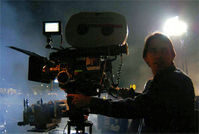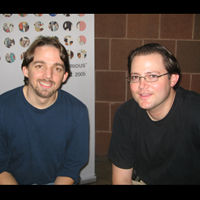Interview with Director of Photography Matthew Irving
independentfilm.com met with Matthew at Resfest in New York.
Published Sep 23, 2005
[an error occurred while processing this directive]
Edit page New page Hide edit links
How did you get started?
I knew I wanted to get into the film industry when I was six years old and saw “Close Encounters Of The Third Kind” in the theaters. Even as a little kid, I was strangely aware that this was a fictional work that someone had created, and I was amazed at the effect it had on all the adults around me. I was aware of the energy of the audience, and I loved every minute of it. I started shooting Super-8mm movies with my older brother Rick when I was nine years old. We’d get the film back from the lab and add laser beams with a red pen. The funny thing is, the Super-8 frame is so tiny that even the thinnest-tip pen would make these enormously thick red beams. It was quite comical in retrospect, but it worked well enough at the time.
I did everything film-related that a kid growing up in a small New Jersey town could do: I started writing scripts, shot several video projects with my friends, and read every book and magazine I could find. And I kept watching movies. Lots and lots of movies. When I finally went away to college at Stanford University in California, I did everything I could to stay in the film world. I continued writing, took part in an amazing internship at the legendary special effects facility Industrial Light and Magic, and—most importantly—I directed, shot, and edited my first 16mm film projects. This latter experience was the first time I began to concentrate on cinematography.
After graduating Stanford, I moved to Los Angeles and entered the graduate film program at the University of Southern California School of Cinema/Television. It was a great time in my life, not necessarily because of any particular classroom experience, but because I was enrolled with a uniquely talented and supportive group of fellow filmmakers. And the great thing was: I’d found my passion for cinematography in an environment where everyone else wanted to be a director. Every director needs a cinematographer, so I quickly became a hot commodity and started accumulating good footage for a decent reel.
One month after achieving my MFA at USC, I started shooting my first feature film with director Tony Barbieri. It was a micro-budget art-film called “One”, shot on Super-16, but it did the trick. “One” went to Sundance 1998, received almost unanimous critical acclaim, and launched my career as a professional Director of Photography. I also met my future wife Cindy at Sundance ’98—making it “Best Festival Ever”. Two years later, I was back at Sundance with the crowd-pleasing rave flick “Groove”, which got picked up in a bidding war and released by Sony Classics. From that experience, I landed myself one of the best cinematography agents in town and have been shooting features steadily ever since.
What are some of the projects that you are working on now? Who are you working with?
Recently, I’ve had the pleasure of shooting a widely eclectic mix of projects with a lot of very talented people. Just outside Nashville, I shot “Daltry Calhoun” for Miramax Films and Executive Producer Quentin Tarantino. This quirky comedy/drama stars Johnny Knoxville and Juliette Lewis, and was directed by Katrina Holden Bronson. In New Orleans, I was the D.P. on “Waiting”, an ensemble comedy directed by Rob McKittrick that will be in theaters on October 7th. This flick stars Ryan Reynolds, Anna Farris, Justin Long, and Luis Guzman, and takes place almost entirely within a Bennigans-style restaurant. In Richmond, Virginia, I did some work on a horror movie called “Cry Wolf”, which was #5 at the box office the weekend of September 16th. The D.P. who shot the main body of the film (Romeo Tyrone) was unable to participate in an extra week of additional photography, so I jumped in and finished it off. We ended up shooting about 25 pages of material in four days! That was a very different kind of experience for me, because I wanted to be respectful of the fine work Romeo had done on the rest of the film. It’s a totally different exercise to match someone else’s style than to generate a style of your own.
Are the camera and film choices the same on all of your shoots or are they different? Do you get to choose? Are you known for a particular style or do you try to shoot what is described to you, what the director wants?
No two film experiences are exactly the same. The constant in all of my projects is the way I like to work with the director. I’ve always believed that the visual style of a movie should have a well-defined arc that reflects the arc of the main characters. I work very intensely with the director to discover and develop this arc for each and every unique project, so that the finished film will feel like a journey, with a palpable sense of cohesion.
My precise level of involvement on a film varies a little bit with each different director. Very few of them come to a project with every camera angle already decided—so that’s where I come in. Director Michael Davis was a big exception. He’d had previous experience as a storyboard artist and had already directed several features, so when we did “Monster Man” together for Lion’s Gate Entertainment, he already had every shot storyboarded and every sequence pre-edited in his mind. Most of the directors I work with, however, depend heavily on my involvement to translate their overall vision into a specific, well-defined, shootable visual style.
As far as actually getting this vision onto a strip of film, I definitely have “my guys” I like to work with whenever I can. However, since my projects end up shooting all over the U.S., and there are often restrictions placed upon me for budgetary reasons, I’m usually forced to bring only a few of my “regulars” and hire the rest locally. Luckily, I’ve been fortunate enough to find great crews wherever I’ve worked: Kentucky, Tennessee, Louisiana, Virginia, California, and even Nova Scotia, Canada.
All of my features have been shot on film, though I’ve shot short subjects and a travel/reality show for television on various digital video formats. My camera rental house of choice is Panavision. They’ve got great customer service, and their gear has never let me down. For me, at the end of the day, it’s all about optics. When I shoot film, I’m shooting with Panavision lenses; when I shoot video, I’m shooting with Canon.
What are your preferred shooting locations?..indoor, outdoor.
I don’t necessarily prefer stages over practical locations. Stage work certainly gives you more control, but there’s a weird kind of inspiration that’s gained by working within the confines of practical locations. I really thrive on the kind of hair-pulling adrenaline-induced compromises that are made out of pure necessity. I think some of the most creative choices are made under non-ideal circumstances. In those moments, I always think to myself, “what would JAWS have been if the shark had worked?” Spielberg and Co. were forced to “cut around” the shark because the mechanical beast was never working properly. If it had, the audience would have seen much more of the shark, and the classic sense of menace may well have been lessened.
Do you ever think about directing someday?
I absolutely do NOT want to direct. I love being a cinematographer and am extremely proud of my role on the set. I look forward to a long career of watching directors schmooz and hob-nob their way to an ulcer, while I kick back with my great family of camera assistants, grips, and electricians. As a cinematographer, I have a maximum amount of creative input with a minimum amount of political game-playing and BS.
Do you like to shoot Documentaries or Narrative? What challenges does each present to a DP?
I’m definitely more narrative-based, although I’ve done a few documentaries (such as the television travel/reality show “Cool Fuel Roadtrip”). Narratives simply inspire me more; it’s the reason I got into the business in the first place. My obsessive-compulsive brain also prefers the relative level of control that you have in a narrative-based environment. I’m a pre-planning fanatic, and a lot of my reputation is based on the work that I put in ahead of time to make sure that a day of shooting runs like clockwork.
From a D.P. perspective, what are some of your favorite movies that show good camera work and cinematography?
One of the films that definitely inspired me to become a cinematographer is “Empire Of The Sun”. Steven Spielberg and Cinematographer Allen Daviau deliver shot after shot of beautifully composed, stunningly-lit, lyrical camera moves that perfectly create a surreal kind of “magical realism”. The camera movement in this movie is my favorite kind: often slow and sensuous, and always perfectly composed. Too much camera movement these days is self-conscious and “showy”, and there are often sloppy moments between Point A and Point B. In “Empire Of The Sun”, you could press “pause” at ANY given moment, and have a perfectly composed image to hang on your wall.
Another big inspiration is “The Graduate”. I think it’s a perfect combination of character, story, blocking, lighting, widescreen composition, and camera movement. There are major lines of dialogue delivered in complete silhouette, and it absolutely works. No one is daring enough to do that kind of thing anymore. It seems that, all too often these days, the star has to be lit perfectly at every moment, for each and every syllable. But not in “The Graduate”… it’s amazing to behold – and it’s all part of what I consider to be the “Golden Age” of cinema. Okay, that’s pretentious, but it’s just my personal opinion, so whatever.
For me, this “Golden Age” is 1968 thru 1982. During this time period, we had major studio releases that were also genuinely visionary and artistic. It was, in my opinion, a period of perfect balance between art and commerce. This time period saw “2001: A Space Odyssey”, “Harold And Maude”, “Taxi Driver” and “Raging Bull”, “Annie Hall”, “The Last Picture Show” and “Paper Moon”, “Days Of Heaven”, “Apocalypse Now” and “The Godfather”, “Network”, “All That Jazz”, and “Blade Runner”—to name just a few! It even includes the original “Halloween”, “Star Wars” and “Raiders Of The Lost Ark”—great mainstream flicks that were also extraordinarily well-made! It’s a very inspiring time period that I love to revisit when I need to re-charge my creative batteries.
What did you like about resfest?
Resfest is a fun event because the emphasis is on homegrown technologies. You have a lot of really cutting edge work from passionate people who aren’t even necessarily trying to translate these projects into a living. Most of them are genuinely trying to create art, to say something with their work. It might seem like a naïve statement, but Resfest feels very pure and refreshing to me, lacking the sense of desperation that you feel at a lot of festivals. It’s more like a community of artists than a competition to get noticed.
[In Technology]
Additional Events at ProFusion 2011, DV Expo East, and Columbia College Chicago May 26, 2011
[In Resources]
Fest to fete special guests Vera Farmiga, Paul Haggis; Mike O’Malley joins Anne Meara as hosts of Late Night Storytelling May 26, 2011






Add a Comment
Please be civil.